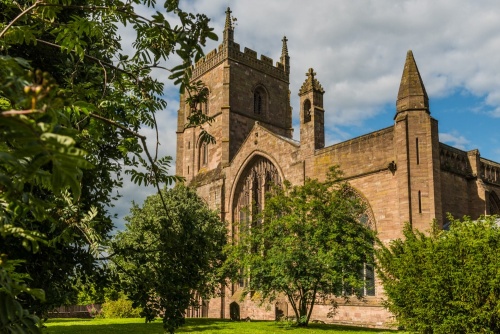
The church is especially notable for the superb 12th-century carving of the west doorway, which has exceptional carved capitals inside and out.
This carving was executed by the 'Herefordshire' school of craftsmen, who were also responsible for the superb churches at Kilpeck and Shobdon, among others in the area. One of the interior capitals depicts a Green Man, the wild man of the woods figure linked to pagan fertility symbols.
The architecture is largely Early English, or Decorated Gothic. Within the priory are copies of monastic manuscripts dealing with the history of the priory and a 13th-century wallpainting depicting the Biblical 'Wheel of Life'.

History
Around AD 660 St Edfrith converted King Merewald of Mercia to Christianity and a nunnery was established at what is now Leominster. Even that 7th-century church may not have been the first, for an old legend says that St David founded a church here a century earlier.
The nunnery was destroyed by Danish raiders in the 9th century and re-founded as a secular college, and then as a nunnery once more. The nunnery had ceased to exist by 1046 but in 1121 Henry I gave the ruined church and the estate of Leominster to his new abbey at Reading. Under the care of Reading Abbey, the church became a Benedictine priory and a cell of Reading.
With royal patronage behind the monks of Reading Abbey, they could afford to rebuild the priory on a grand scale.
In the 13th century, a second nave was added to the first, and in the 14th century, a south aisle was built on a scale to equal the naves. It is the combination of these three long, rectangular spaces that gives Leominster Priory such an unusual layout today, as if it had three naves.
The Priory was eventually suppressed by Henry VIII and most of the monastic buildings were torn down, but part of the priory church was saved to become the parish church. The town kept the church naves but the monastic chancel, side chapels, cloisters, presbytery and transepts were all pulled down.
The church was restored by Sir George Gilbert Scott in 1866 and again in 1878.

The Ducking Stool
Leominster Priory is home to the last ducking stool used in England. The ducking stool was a form of punishment often reserved for unscrupulous merchants and for wives whose husband's thought they were too opinionated, but it could also be used as a more deadly form of test for witchcraft.
If a suspected witch was ducked under the water and died, they were presumed to have been innocent. If they survived, it was presumed that the devil had saved them, so they could be executed as a proven witch.
The Leominster ducking stool was fitted with wheels as early as 1566. That made it possible to move the stool around town. It was fitted with irons to retrain the prisoner and a link that allowed the chair to be suspended high in the air for the public to see the prisoner's disgrace.

The ducking stool was last used in 1809. A woman named Jenny Pipes was found guilty of using foul and abusive language. She was paraded through the streets in the ducking stool and then ducked in the Kenwater in front of a crowd of onlookers that included the Mayor. The ducking didn't serve very well as a deterrent, for no sooner was Pipes released than she repeated the infringement.
The stool was in action a few years later in 1817 when Sarah Leeke was sentenced to a similar fate. She was wheeled around Leominster in the ducking stool but when the procession came to the river it was discovered that the water level was too low for ducking.








 We've 'tagged' this attraction information to help you find related historic attractions and learn more about major time periods mentioned.
We've 'tagged' this attraction information to help you find related historic attractions and learn more about major time periods mentioned.



